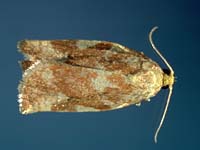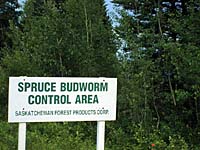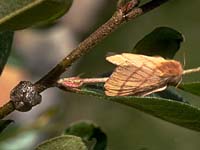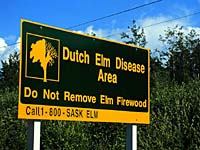

Another less familiar aspect of forest protection involves the detection and control of insects and diseases such as Dutch elm disease, spruce budworm (moth shown left), dwarf mistletoe and mountain pine beetle. Minimizing the destructive impact of insects and diseases on the forest is an important aspect of forest management. |

A pest management program was created to monitor and respond to insect and disease outbreaks. If an infestation occurs, it is surveyed and treated appropriately. In 1992, for example, there was a fivefold increase in damage caused by the spruce budworm, which affected 87 000 hectares of forest. To respond to this threat, forest managers have combined sanitation harvesting with the use of a biological pesticide. In 1992, an 8000 hectare area of the infestation was sprayed with the biological insecticide, Bacillus thuringiensis var. kurstaki (Bt), with encouraging results; the spruce budworm population in the sprayed area was reduced. |

Other insect damage common to Saskatchewan's forests is caused by the forest tent caterpillar (moth and eggs shown left), northern pitch twig moth, jack pine budworm and terminal weevils. |

Diseases most common to the province include Armillaria root rot, Atropellis canker, western gall rust, dwarf mistletoe and Dutch elm disease. Treatments for these and other diseases range from salvage logging to sanitation thinning or pruning. The use of improved silvicultural management techniques plays a key role in the prevention of forest tree diseases. |